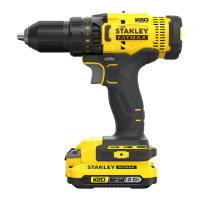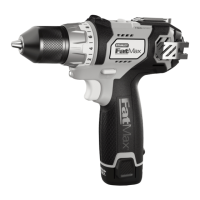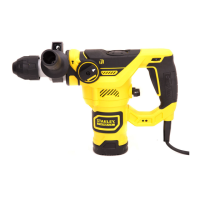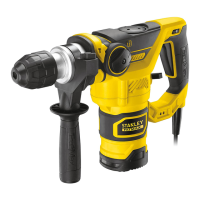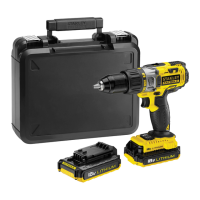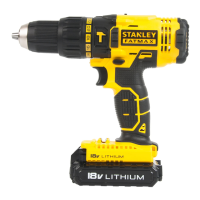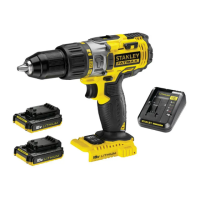10
ENGLISH
(Original instructions)
Drilling in wood
Holes in wood can be made with the same twist drill bits used
for metal or with spade bits. These bits should be sharp and
should be pulled out frequently when drilling to clear chips
from the utes.
Drilling in metal
Use a cutting lubricant when drilling metals. The exceptions
are cast iron and brass which should be drilled dry. The cutting
lubricants that work best are sulphurized cutting oil.
Drilling in masonry
For drilling in masonry, set the collar (3) to the hammer drilling
position by aligning the symbol with the marking. Use carbide
tipped masonry bits. . Keep even force on the drill. A smooth,
even ow of dust indicates the proper drilling rate.
LED work light (Fig H)
When drill is activated by pulling the trigger switch (1), the
integrated LED work light (6) will automatically illuminate the
work area.
Note: The work light is for lighting the immediate work surface
and is not intended to be used as a ashlight.
Troubleshooting
Problem Possible cause Possible solution
Unit will not start. Battery pack not
installed properly.
Battery pack
not charged.
Check battery
pack installation.
Check battery pack
charging requirements.
Unit starts
immediately upon
inserting battery
The switch has
been left in the
“on” position.
The switch must be moved
to “off” to prevent the tool
from immediately starting
when battery is inserted.
Battery pack will
not charge.
Battery pack not
nserted into charger.
Charger not
plugged in.
Surrounding air
temperature too hot or
too cold.
Insert battery pack into
charger until LED lights.
Plug charger into a
working outlet.
Move charger and battery
pack to a surrounding
air temperature of above
45 °C or below +40.5 °C.
Unit shuts off abruptly. Battery pack has
reached its maximum
thermal limit.
Out of charge. (To
maximize the life of
the battery pack it is
designed to shutoff
abruptly when the
charge is depleted
Allow battery pack to cool
down.
Place on charger and allow
to charge.
Maintenance
Your STANLEY FATMAX tool has been designed to operate
over a long period of time with a minimum of maintenance.
Continuous satisfactory operation depends upon proper tool
care and regular cleaning.
Your charger does not require any maintenance apart from
regular cleaning.
Warning! Before performing any maintenance on the tool,
remove the battery from the tool. Unplug the charger before
cleaning it.
u Regularly clean the ventilation slots in your tool and
charger using a soft brush or dry cloth.
u Regularly clean the motor housing using a damp cloth.
u Do not use any abrasive or solvent-based cleaner.
Protecting the environment
Z
Separate collection. Products and batteries marked
with this symbol must not be disposed of with
normal household waste.
Products and batteries contain materials that can be
recovered or recycled reducing the demand for raw materials.
Please recycle electrical products and batteries according to
local provisions. Further information is available at
www.2helpU.com
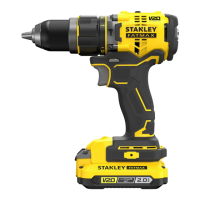
